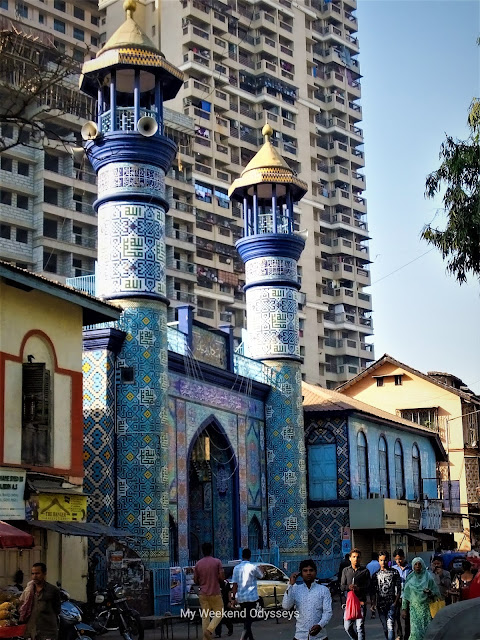A slice of Persian architecture and Dawoodi Bohra shrine in Bhendi Bazaar
One of the online articles I read, referred to a Masjid in Mumbai with gleaming blue Persian tiles with a well-maintained lawn and a pond. My first reaction was is this in Mumbai? So on the first opportunity on one weekend, I was on my way to see this slice of Persia in the middle of the narrow bylane of Dongri tucked away from chaotic traffic and hidden by nondescript eateries and shops.
Off the chaotic traffic of Mohamed Ali Road, on Imamwada road and hidden by series of eateries and shops, lies the two minaret mosque called "Masjid - e - Iran" or popularly known as "Mughal Masjid". It is said to be the oldest remnant of Iranian heritage in Mumbai which has withstood the travails of time for more than 150 years. The things that attract you most are the tall minarets and the entire exterior & interior of the mosque which is gleaming with blue mosaic tiles.
History of Mughal Masjid: This Shia place of worship was built by a wealthy Iranian merchant in 1860, Haji Mohamed Hussein Shirazi. Bhendi bazaar was then an uptown and a hub of merchants with trading connections with Persia and the middle east. These traders contributed heavily to the construction of religious places in the Dongri area. The Masjid was built on lines of the mosque in the town of Shiraz in Iran. This is one particular reason that Mughal Masjid doesn't have a dome but only two minarets. The mosque is today maintained by a trust run by the family of the Iranian Merchant. Though it underwent some major restoration a few decades back care was taken to ensure that it retains its original glory.
Architecture: The caretaker of the Mosque informed us that the exterior facade which is dotted with translucent tiles, the carpets in the interior halls as well the ornate crystal chandeliers have all been imported from Iran. The foundation of Mehrab or inner sanctum is made of mud from the holy city of Karbala in Iraq which is considered as Holy Mecca for the Shia community.
Intricate work on the front boundary walls of the Masjid is not only stunning but the most beautiful seen anywhere in Mumbai. Verses of the Quran have inscribed on the minarets as well as archway in Kufic and Sullus calligraphy. Onyx and granite have been freely used in the interiors.
As we step inside the courtyard, the place seems to be like an oasis in the middle of the chaotic neighborhood. As mesmerizing as the exterior is, inside the boundary walls lies a well maintained lawn, a pond with clean water and fountains, palm trees, and a prayer hall. The rectangular pond is also known as "Hauz" was the place where ablutions would be done once but now taps have been constructed and the pond is now more of a decorative piece adding charm to the courtyard.
Though non-Muslims are not allowed inside the prayer hall, one can still get a peep from the outside and get amazed by the beauty the place holds. Sitting on the steps outside the prayer hall, the caretaker provided us with much-needed information about the place. The peace and serenity that the place provides is second to none and fry cry from the noisy neighborhood outside.
Truly the place is rightly termed as "Urban Oasis" in Mumbai and the mosque has a space beyond prayers providing relaxation in the true sense.
The best time to visit would be early morning and in between nonprayer hours.
Raudat Tahera: Another important place of worship for the Dawoodi Bohra Shia Ismaili community and stone throw away from Mughal Masjid is Raudat Tahera. It is a mausoleum of Syedna Taher Saifuddin and his son - the 51st and 52nd religious heads of the Dawoodi Bohra community.
Important features: The white marbled shrine was constructed by the same architect who designed Mazar e Quaid in Pakistan. The entire building is made of white marble quarried from mines of Makrana - the same place from where marbles were used for the construction of the Taj Mahal.
The mausoleum raises to a height of 108 feet and has a 52 feet dome which is its crowning feature. The central dome has four smaller domes at each corner, The entire structure is inspired by Juyushi Mosque in Cairo.
What gives this tomb a unique place of honor amongst all the monuments not only in India and the world is the interior of the dome which has an inscription of the Holy Quran on all four walls written in pure gold.
This makes it probably the only monument in the world which has the entire Quran engraved within its sanctum sanctorum. The dome has the tomb of both the religious leaders with a glittering crystal chandelier suspended from the center casting its divine light on the precinct.
Another notable thing was apart from the inscription of the Quran in gold, there are 113 phrases which is recited before each chapter of the Quran known as "Bismillah" is also inscribed on the wall with studded rubies, diamonds, emeralds, and precious stones.
Not many people are aware of this shrine apart from people from the Shia community and the locals. It is also not in the list of tourist attractions of Mumbai. In fact, when we visited the place it was covered and hidden under the tarps to protect it from nearby construction activities of the area.
The above gold door has been bought from the holy mosque at Karbala in Iraq.
The shrine can be visited with prior permission.
The place is walkable distance from many food attractions in the area as well as from the famous "Chor Bazaar" of Mumbai.



























Comments
Post a Comment